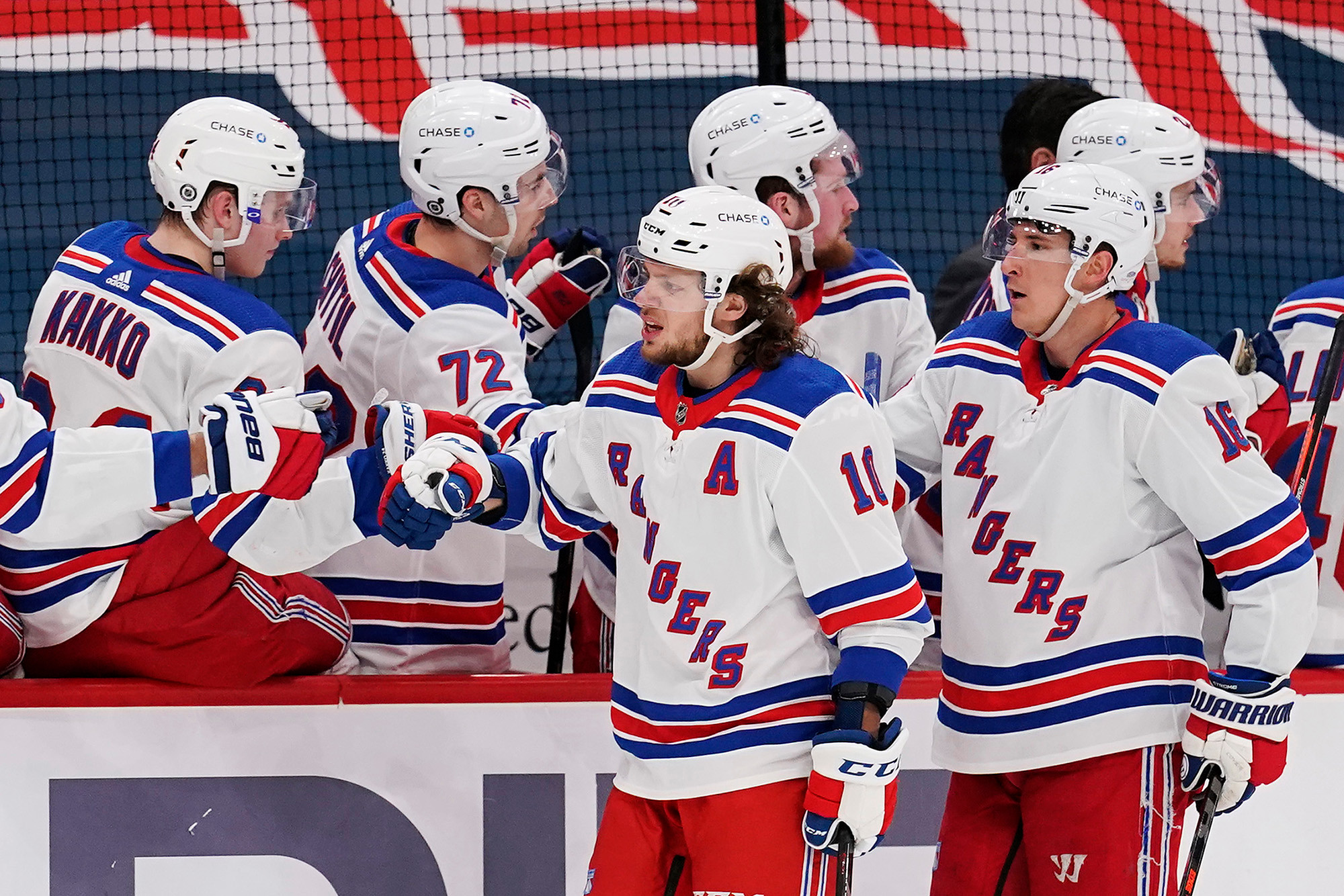More On: chris kreider
Rangers’ changes help them close playoff gap with win over Flyers
A crucial Rangers experiment is just getting started
Rangers stars crumble under pressure again in worrisome sign
Why an unlikely Rangers playoff appearance would be so illuminating
Rangers fall to Penguins despite promising Keith Kinkaid start
Do you know why it would be so beneficial for the Rangers to make the playoffs? Because then we would have another year of evidence to examine in determining whether the style of play favored by their
More from:
Larry Brooks

NHL unlikely to need COVID-19 vaccine incentives for players
Rangers have an entitlement problem with their power play
Rangers rightly going to ride Igor Shesterkin the rest of way
Colin Blackwell is forcing the Rangers into uncomfortable dilemma
NHL's referee problem goes way beyond Tim Peel debacle
Do you know why it would be so beneficial for the Rangers to make the playoffs? Because then we would have another year of evidence to examine in determining whether the style of play favored by their top six can succeed in the postseason.
All of the data and all of the eye-tests from last August’s misadventure under the bubble against Carolina combine to produce great skepticism that this east-west, pass-happy, talent-based approach that produces intermittent great bursts throughout the regular season can pass muster in tournament play.
Ryan Strome, who has emerged as one of the league’s most productive centers since hooking up with Artemi Panarin at the start of last season, pretty much threw down the gauntlet on Thursday following the Rangers’ overtime victory in Buffalo.
He might as well have told the coaching staff, “Thanks for the advice, but no thanks.” This was about as much swagger as a Ranger has displayed since Mark Messier swatted Doug Gilmour upside the head in front of the Devils’ bench in Game 2 of the 1997 second round and strutted through the rest of the series without opposition.
“I think we could shoot the puck more, I think sometimes we tend to shoot for quality not quantity and sometimes it helps us and sometimes it doesn’t,” said No. 16. “So I think especially with our top guys you can’t micromanage it.
“I think you have to trust that we see the right play and that we’re going to make the right play.”
So what can we deduce from that declaration? That the Rangers’ top six — or at least the five veterans including Strome, Panarin, Mika Zibanejad, Chris Kreider and Pavel Buchnevich — are going to dance with the ones that brung ‘em to the show. And dance. And dance. That’s who they are.

Maybe if the top-six had accomplished anything last summer against the ‘Canes, their approach would inspire more confidence. Of course, you could argue that last summer’s experience was so devoid of context that it should be disregarded.
That is why a second go-round — fanciful at this stage — would be so illuminating. Maybe Strome’s point would be reinforced. Maybe it would not.
Strome’s 2.03 points per 60:00 at five-on-five since the start of last season ranks 11th in the league among centers with 1,400 minutes. His 2.7 points per 60:00 overall ranks 16th among centers with at least 1,700 minutes. That is first-line production.
So would a Cup contender come after Strome at the April 12 trade deadline? Teams seeking to add assets don’t generally subtract them at the same time.
Thus, if a team were to offer a first-rounder for the 27-year-old, under contract for an equitable $4.5 million for another year, would the Rangers do it?
Does the organization really need what would be projected as a late first-rounder in exchange for a top-six guy this deep into their reconstruction?
No, it does not, unless including that pick in a package would allow the team to acquire a substantial top-six/top-nine will-more-than-skill guy.
Meanwhile, Kreider has gone 11 straight games without a five-on-five goal in 151:10 through which he has taken 10 shots and 20 attempts.
No. 20 leads the team with 17 goals. He is in a three-way tie for second in the NHL with nine power-play goals, two behind leader Joe Pavelski. He has value.
But Kreider’s game has become so specialized. Maybe it’s because the guy on TV is always proclaiming how No. 20 has to get to the back post, but that is exactly what Kreider’s game essentially boils down to at this point. He goes to the back post. He is a substantial net-front presence, yes, but he rarely has the puck on his stick through the neutral zone and he rarely shoots the puck from farther than five feet out.
Per Natural Stat Trick, Kreider is averaging 4.95 five-on-five shots per 60:00, dramatically down from not only last year’s 8.2 but from each one of his seven preceding full seasons in the NHL where he ranged from between 7.09 (2015-16) and 8.73 (2017-18).
That is a consequence of Kreider’s game fitting almost entirely into about a 6-by-4 rectangle in front of the net. It might be best for the winger to broaden his horizons.
Similarly, it might be best for David Quinn to shake it up at the top and shift Kreider to Strome’s left while Panarin moves up to play with Zibanejad.
Kreider has recorded five goals and seven points with 16 shots in 139:28 with Strome at five-on-five. He has posted two goals and six points with 17 shots in 295:58 with Zibanejad. Hmm.
The Rangers, who start a two-game set at the Garden against the Penguins on Tuesday, have scored 10 goals at five-on-five over the last five games while going 2-2-1. This is the time to make that change.
This story originally appeared on: NyPost - Author:Larry Brooks












